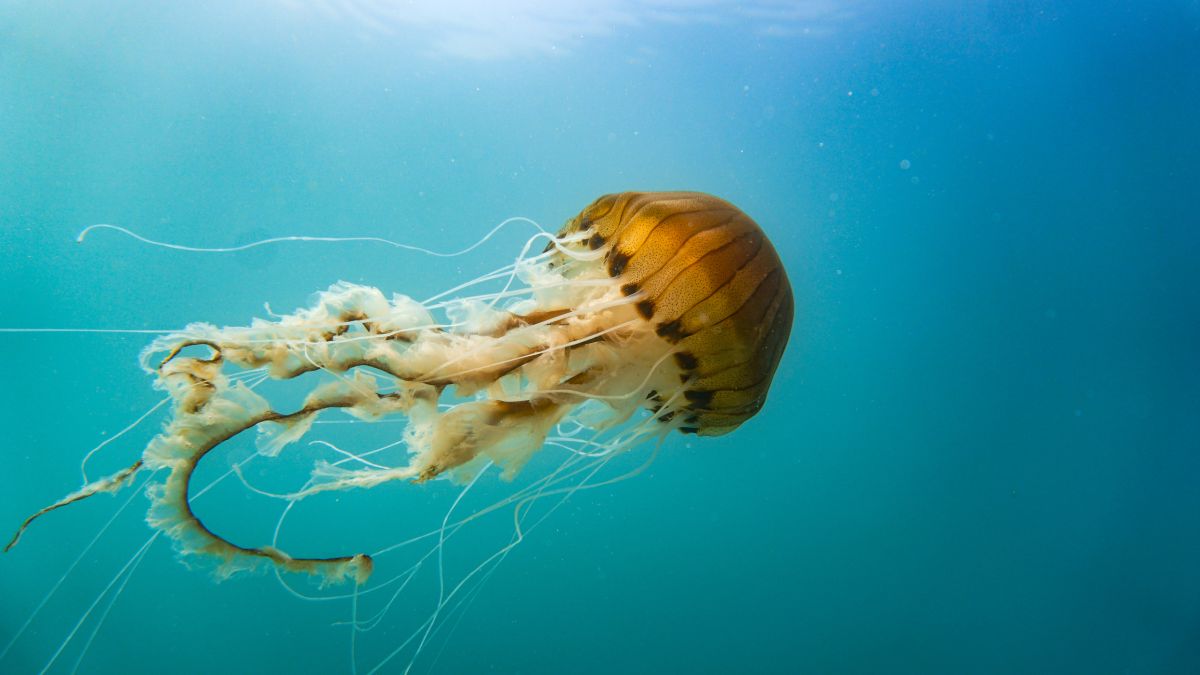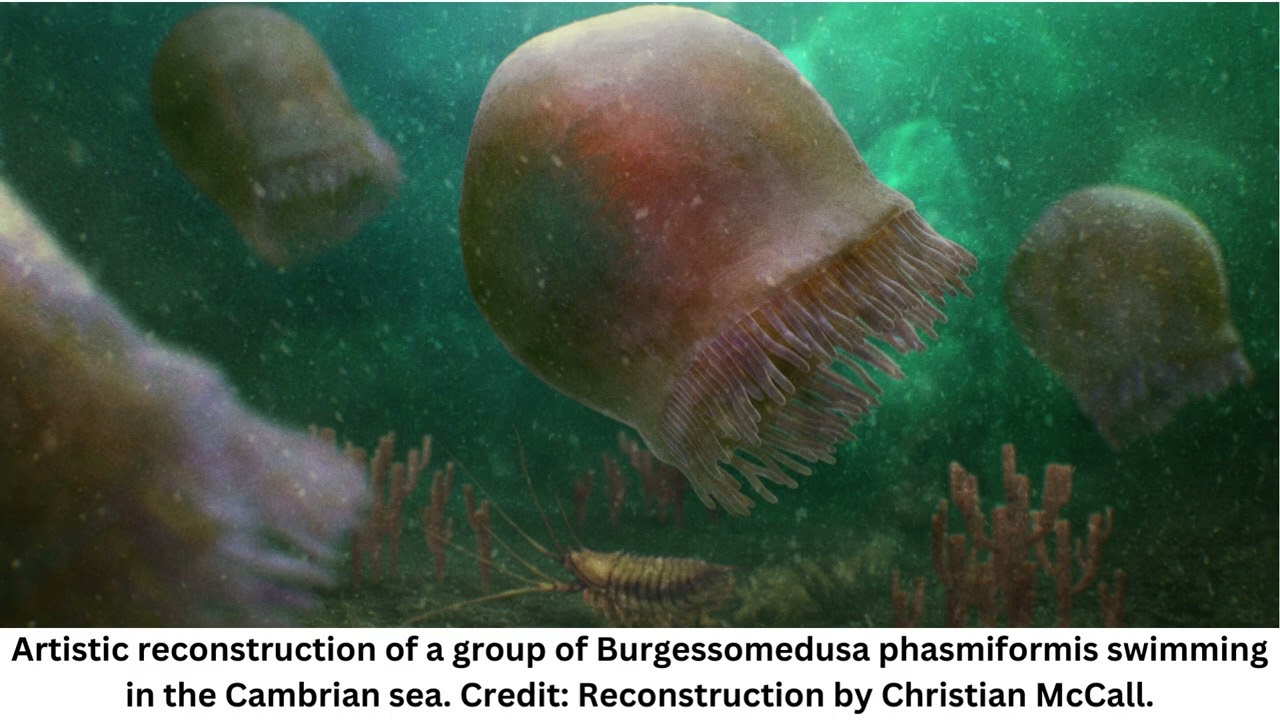508-Million-Year-Old Fossils May Be The Oldest Species Of Swimming Jellyfish
Jellyfish are a familiar sight at the beach, either pulsing gracefully underwater or washed up on the shore. These soft-bodied creatures also serve as a fascinating link to the ancient past. Recently, scientists made a remarkable discovery that may lead them to assume that some 508-million-year-old fossils may be the oldest species of swimming jellyfish on Earth.
Author:Daniel JamesReviewer:Anderson PattersonAug 03, 202311K Shares305.6K Views

Jellyfish are a familiar sight at the beach, either pulsing gracefully underwater or washed up on the shore. These soft-bodied creatures also serve as a fascinating link to the ancient past. Recently, scientists made a remarkable discovery that may lead them to assume that some 508-million-year-old fossils may be the oldest species of swimming jellyfishon Earth.
This prehistoric jellyfish, known as Burgessomedusa phasmiformis, had an umbrella-like structure and measured approximately seven inches across. Its body was adorned with over 90 short tentacles that dangled beneath it.
The fossil, found in the mountains of British Columbia, provides concrete evidence that these ancient jellies once roamed reefs, where their tentacles skillfully captured prey swimming in the water, much like modern jellyfish do today. The discovery sheds new light on the ancient ecosystems and the remarkable longevity of jellyfish as a species.
"Sometimes in paleontology you know a great discovery as soon as it’s made in the field," says Royal Ontario Museum paleontologist and study author Joseph Moysiuk.
In the 1980s and 1990s, teams from the Royal Ontario Museum embarked on an expedition to uncover fossils of ancient life within the layers of the Burgess Shale. These fine-grained rocks preserve the remains of reef life from over 508 million years ago. The Burgess Shale is renowned worldwide for its exceptional collection of fossils, particularly those of enigmatic soft-bodied creatures that thrived during a critical period of early animal evolution when arthropods and mollusks were just emerging.
During the excavation, the field teams stumbled upon remarkably well-preserved fossils that stood out from the rest. Unlike many Burgess Shale specimens that posed challenges due to their unusual anatomies, these fossils were relatively large and distinct, even when encased in mud.

Spectacularly Preserved Jellyfish Found in 500-Million-Year-Old Rock
The paleontologists quickly recognized them as early jellyfish, but it would take several years before a comprehensive formal description of these fossils was undertaken. Finally, after thorough research and analysis, the findings were published in Proceedings of the Royal Society B, officially confirming the identity of these ancient jellyfish and shedding new light on the fascinating history of early marine life.
“„Finding such incredibly delicate animals preserved in rock layers on top of these mountains is such a wondrous discovery.- Dr Jean-Bernard Caron, a curator of invertebrate palaeontology at the Royal Ontario Museum
In the Raymond Quarry, researchers, including Moysiuk and his colleagues, have discovered a total of 182 fossils belonging to Burgessomedusa. Surprisingly, these fossils remained elusive for a considerable period due to their apparent rarity compared to other findings in the same location. The reason behind their scarcity remains unclear, and Moysiuk speculates whether these ancient jellies might have preferred to dwell high in the water column, beyond the reach of mud flows that ultimately buried the ancient seafloor communities.
The quest to find Cambrian Period jellyfish has spanned over a century, but it hasn't been without challenges. In 1911, Charles Doolittle Walcott, then-administrator of the Smithsonian Institution, believed he had stumbled upon a small, circular jellyfish based on an intriguing disc-shaped fossil found in the Burgess Shale. This discovery influenced artists to depict Cambrian life with modern-looking jellyfish sporting trailing tentacles.
However, subsequent research revealed that these fossils were not jellyfish at all; they turned out to be the mouthparts of a peculiar arthropod named Peytoia, which had large, flexible appendages used to grasp soft prey. Such cases remind us of the intricacies involved in identifying ancient organisms and the ever-evolving nature of paleontological research.
Despite previous cases of mistaken identity, paleontologists have long believed that jellyfish were among the animals that originated during the Cambrian Period. The assumption was that jellyfish, with their ancient roots, would have left traces alongside other Cambrian creatures in the fossil record. After more than a century of searching, their expectations are finally being met, as recent discoveries have started to unveil the existence of ancient jellyfish.
In 2007, researchers from the University of Kansas, led by Bruce Lieberman, described medusa jellyfish from the 505-million-year-old Marjum Formation in Utah. Subsequently, another group of paleontologists reported similar fossils from 521-million-year-old rocks in China's Yunnan Province in 2016.
However, there is ongoing disagreement among researchers regarding the identities of these previously described fossils. Moysiuk and his colleagues propose that these findings represent comb jellies, which belong to a different phylum and have distinct characteristics from true jellyfish. While comb jellies may seem superficially similar and are approximately equally old, they are classified under a different branch of the tree of life.
Lieberman, who was not involved in the new study, disagrees with this interpretation. He emphasizes the exceptional preservation of the Utah and China fossils and firmly asserts that they are indeed jellyfish, not comb jellies, as suggested by the new study.
Despite the disagreement over the specific fossils, Lieberman highlights the significance of the new study in highlighting the importance of the Cambrian Period for jellyfish evolution. He commends the discovery of new Cambrian fossil evidence, reinforcing the idea that medusozoans (jellyfish and their relatives) were already established and played a vital role in the ecosystem during the Cambrian era.
Caron said, "This adds yet another remarkable lineage of animals that the Burgess Shale has preserved chronicling the evolution of life on Earth."
Although Burgessomedusa bears a resemblance to jellyfish, it cannot be classified directly into any specific modern jellyfish group. According to Moysiuk, the creature displays characteristics found in various contemporary jellyfish groups but doesn't fit precisely into any single category.
Its physical structure is similar to the notorious box jellyfish, while its tentacles resemble those of moon jellies. Moysiuk speculates that this combination of traits suggests Burgessomedusa could be a close relative of the common ancestor from which our familiar modern jellyfish evolved diverged.
The Cambrian era, spanning from 541 million to 485 million years ago, held immense significance for life on Earth. During this crucial period, numerous animal body forms that we observe today, including our own, started to take shape, laying the foundation for the subsequent 500 million years of evolutionary developments.
Conclusion
“„Burgessomedusa represents one more major animal body plan that can trace its roots back to the Cambrian. A striking and humbling reminder of how much biodiversity had already taken shape by half a billion years ago.- Joseph Moysiuk
Jump to

Daniel James
Author
Daniel James is a distinguished gerontologist, author, and professional coach known for his expertise in health and aging.
With degrees from Georgia Tech and UCLA, including a diploma in gerontology from the University of Boston, Daniel brings over 15 years of experience to his work.
His credentials also include a Professional Coaching Certification, enhancing his credibility in personal development and well-being.
In his free time, Daniel is an avid runner and tennis player, passionate about fitness, wellness, and staying active.
His commitment to improving lives through health education and coaching reflects his passion and dedication in both professional and personal endeavors.

Anderson Patterson
Reviewer
Anderson Patterson, a tech enthusiast with a degree in Computer Science from Stanford University, has over 5 years of experience in this industry.
Anderson's articles are known for their informative style, providing insights into the latest tech trends, scientific discoveries, and entertainment news.
Anderson Patterson's hobbies include exploring Crypto, photography, hiking, and reading.
Anderson Patterson's hobbies include exploring Crypto, photography, hiking, and reading.
In the Crypto niche, Anderson actively researches and analyzes cryptocurrency trends, writes informative articles about blockchain technology, and engages with different communities to stay updated on the latest developments and opportunities.
Latest Articles
Popular Articles
